Related Research Articles

Lima is the capital and the largest city of Peru. It is located in the valleys of the Chillón, Rímac and Lurín Rivers, in the desert zone of the central coastal part of the country, overlooking the Pacific Ocean. Together with the seaport of Callao, it forms a contiguous urban area known as the Lima Metropolitan Area. With a population of more than 9.7 million and more than 10.7 million in its metropolitan area, Lima is one of the largest cities in the Americas.

Jorge Mario Pedro Vargas Llosa, 1st Marquis of Vargas Llosa, more commonly known as Mario Vargas Llosa, is a Peruvian writer, journalist, essayist, college professor, and a former politician, who also holds Spanish citizenship. Vargas Llosa is one of Latin America's most significant novelists and essayists, and one of the leading writers of his generation. Some critics consider him to have had a larger international impact and worldwide audience than any other writer of the Latin American Boom. In 2010 he won the Nobel Prize in Literature, "for his cartography of structures of power and his trenchant images of the individual's resistance, revolt, and defeat." He also won the 1967 Rómulo Gallegos Prize, the 1986 Prince of Asturias Award, the 1994 Miguel de Cervantes Prize, the 1995 Jerusalem Prize, the 2012 Carlos Fuentes International Prize, and the 2018 Pablo Neruda Order of Artistic and Cultural Merit.

Peru, officially the Republic of Peru, is a country in western South America. It is bordered in the north by Ecuador and Colombia, in the east by Brazil, in the southeast by Bolivia, in the south by Chile, and in the south and west by the Pacific Ocean. Peru is a megadiverse country with habitats ranging from the arid plains of the Pacific coastal region in the west to the peaks of the Andes mountains extending from the north to the southeast of the country to the tropical Amazon Basin rainforest in the east with the Amazon river. Peru has a population of 34 million, and its capital and largest city is Lima. At 1.28 million km2, Peru is the 19th largest country in the world, and the third largest in South America.
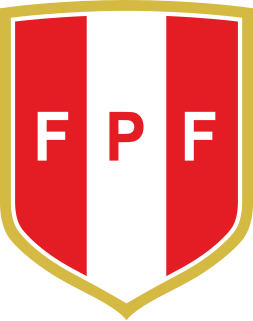
The Peru national football team represents Peru in men's international football. The national team has been organised, since 1927, by the Peruvian Football Federation (FPF). The FPF constitutes one of the ten members of FIFA's South American Football Confederation (CONMEBOL). Peru has won the Copa América twice and qualified for FIFA World Cup finals five times ; the team also participated in the 1936 Olympic football competition and has reached the semi-finals of the CONCACAF Gold Cup. The team plays most of its home matches at the Estadio Nacional in Lima, the country's capital.

A pisco sour is an alcoholic cocktail of Peruvian origin that is typical of the cuisines from Peru and Chile. The drink's name comes from pisco, which is its base liquor, and the cocktail term sour, in reference to sour citrus juice and sweetener components. The Peruvian pisco sour uses Peruvian pisco as the base liquor and adds freshly squeezed lime juice, simple syrup, ice, egg white, and Angostura bitters. The Chilean version is similar, but uses Chilean pisco and Pica lime, and excludes the bitters and egg white. Other variants of the cocktail include those created with fruits like pineapple or plants such as coca leaves.
Chicha Press is a Peruvian nickname for sensationalist tabloid newspapers that first emerged in the 1980s. The etymology of Chicha Press is derived from the name for certain drinks made from corn, which later came to be used by some in Peru describe the culture of Andean migrants to the capital region of Lima during the 1960s. The concept of the Chicha press became a central part of the national culture in 2000 when it was popularized by Alberto Fujimori to discredit opponents of his government in the general elections of 2000.

Peruvians are the citizens of Peru. There were Andean and coastal ancient civilizations like Caral, which inhabited what is now Peruvian territory for several millennia before the Spanish conquest in the 16th century; Peruvian population decreased from an estimated 5–9 million in the 1520s to around 600,000 in 1620 mainly because of infectious diseases. Spaniards and Africans arrived in large numbers in 1532 under colonial rule, mixing widely with each other and with Native Peruvians. During the Republic, there has been a gradual immigration of European people. Chinese and Japanese arrived in large numbers at the end of the 19th century.
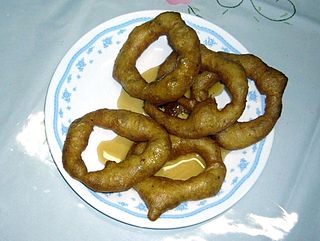
Picarones are a Peruvian dessert that originated in Lima during the viceroyalty. It is somewhat similar to buñuelos, a type of doughnut brought to the colonies by Spanish conquistadors. Its principal ingredients are squash and sweet potato. It is served in a doughnut form and covered with syrup, made from chancaca. It is traditional to serve picarones when people prepare anticuchos, another traditional Peruvian dish.
The Latin American Newspaper Association is a press group representing media organizations in Latin America. Founded in 2008, it represents 16 newspapers in 11 countries, as well as magazines.
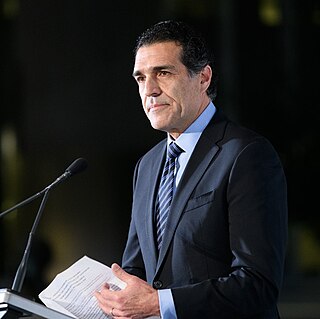
Gonzalo Castro de la Mata is a Peruvian ecologist and writer born in Lima, Peru. He is recognized as a global leader in the promotion of sustainability with emphasis on innovative free market solutions to environmental issues.
The following is a timeline of the history of the city of Lima, Peru.
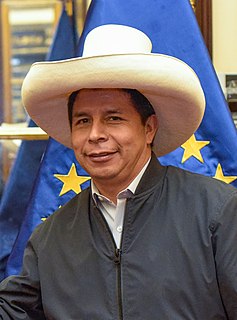
José Pedro Castillo Terrones, sometimes referred to as "El Profe", is a Peruvian schoolteacher, union leader and politician serving as the 130th president of Peru since 28 July 2021, following the 2021 general election.
Carolina Freyre Arias, also known as Carolina Freyre de Jaimes, was a Peruvian poet, playwright, and novelist. She is considered a pioneer among Latin American women journalists.

Free Peru, officially the Free Peru National Political Party, is a Marxist political party in Peru. Founded in 2008 as the Free Peru Political Regional Movement, the party was officially constituted as a national organization in February 2012 by the name of Libertarian Peru. It was registered as a political party in January 2016 and adopted its current name, Free Peru, in January 2019. Its presidential candidate Pedro Castillo won the 2021 Peruvian general election against Popular Force nominee Keiko Fujimori. Free Peru received its first seat in the Congress of Peru in the 2021 election, where it won the most seats of any party – 37 out of 130 total representatives – but its opposition continued to rule Congress after forming a larger alliance of seats lead by the Popular Action party. Free Peru is a participant in the São Paulo Forum, an annual conference of leftist parties in the Americas.
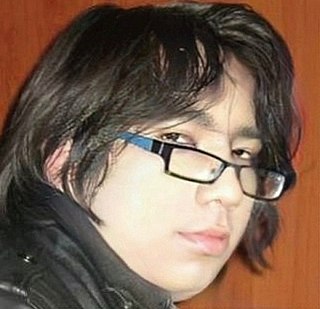
Raúl Alfonso Allain Vega is a Peruvian writer, poet, editor and sociologist. He is a contributor to media such as América Latina en Movimiento, Rebelión, Pressenza, Crónica Popular and La Onda digital.
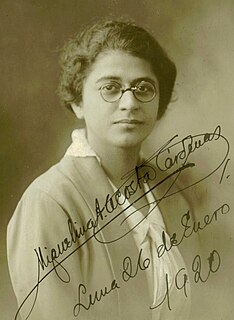
Miguelina Aurora Acosta Cárdenas was a Peruvian feminist, anarcho-syndicalist activist, teacher, and lawyer, who dedicated much of her life to the fight for women's rights, the Amazonian peoples and the working class. She is the first Peruvian woman to graduate in law in Peru and is considered the first female trial lawyer in Peru.
Jesús María Isabel Romero Wiesse was a Peruvian poet, writer, essayist, anthologist, and film critic.
References
- ↑ "El Diario de Lima: así fue el primer periódico del Perú y Latinoamérica". RPP. 1 October 2016. Retrieved 22 April 2020.
- ↑ Michael B. Salwen; Bruce Garrison (5 November 2013). Latin American Journalism. Taylor & Francis. pp. 153–. ISBN 978-1-136-69132-4 . Retrieved 23 April 2020.
- ↑ Mónica Ricketts (2017). Who Should Rule?: Men of Arms, the Republic of Letters, and the Fall of the Spanish Empire. Oxford University Press. pp. 93–. ISBN 978-0-19-049488-9 . Retrieved 23 April 2020.